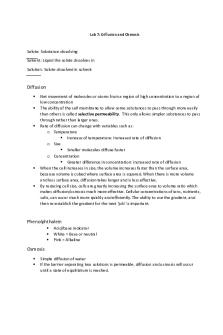Lab 7: Diffusion and Osmosis PDF

| Title | Lab 7: Diffusion and Osmosis |
|---|---|
| Course | General Biology I |
| Institution | Brookdale Community College |
| Pages | 2 |
| File Size | 63.6 KB |
| File Type | |
| Total Downloads | 86 |
| Total Views | 176 |
Summary
These are for the lab class, not lecture, and covers diffusion and osmosis as well as tonicity in animal and plant cells....
Description
Lab 7: Diffusion and Osmosis
Solute: Substance dissolving Solvent: Liquid the solute dissolves in Solution: Solute dissolved in solvent
Diffusion
Net movement of molecules or atoms from a region of high concentration to a region of low concentration The ability of the cell membrane to allow some substances to pass through more easily than others is called selective permeability. This only allows simpler substances to pass through rather than larger ones. Rate of diffusion can change with variables such as: o Temperature Increase of temperature: Increased rate of diffusion o Size Smaller molecules diffuse faster o Concentration Greater difference in concentration: increased rate of diffusion When the cell increases in size, the volume increases faster than the surface area, because volume is cubed where surface area is squared. When there is more volume and less surface area, diffusion takes longer and is less effective. By reducing cell size, cells are greatly increasing the surface area to volume ratio which makes diffusion/osmosis much more effective. Cellular concentrations of ions, nutrients, salts, can occur much more quickly and efficiently. The ability to use the gradient, and then re-establish the gradient for the next ‘job’ is important.
Phenolphthalein
Acid/base indicator White = Base or neutral Pink = Alkaline
Osmosis
Simple diffusion of water If the barrier separating two solutions is permeable, diffusion and osmosis will occur until a state of equilibrium is reached.
Equilibrium: The concentrations of solvent and solute are equal on both sides of the membrane. Water will move to the concentration with the highest concentration o Think – Water is greedy!
Tonicity
Describes the ability of a solution to cause a cell to gain or lose water. There are 3 different types of tonicity: o Hypertonic “Hyper-” prefix meaning “excessive” Higher solute concentration o Hypotonic “Hypo-” prefix meaning “under” Lower solute concentration o Isotonic “Iso-“prefix meaning “equal” Equal solute concentration
Animal Cells vs. Plant Cells in different tonicities
Hypertonic solution o Animal Cell: Crenation (deflated) o Plant Cell: Plasmolysis (deflated) Isotonic Solution o Animal Cell: Normal o Plant Cell: Flaccid Hypotonic solution: o Animal Cell: Lysis (bursting) o Plant Cell: Turgid (swollen - normal)...
Similar Free PDFs

Lab 7: Diffusion and Osmosis
- 2 Pages

Diffusion and Osmosis lab
- 3 Pages

Diffusion and osmosis lab
- 4 Pages

Diffusion and Osmosis lab
- 4 Pages

Lab 4 - Diffusion and Osmosis
- 6 Pages

Lab 4 Diffusion and Osmosis
- 7 Pages

Lab 5 Diffusion and Osmosis
- 1 Pages

Diffusion and osmosis lab 1
- 4 Pages

Diffusion and Osmosis Lab Report
- 8 Pages

Diffusion and Osmosis Lab Report
- 8 Pages

Diffusion & Osmosis Lab
- 10 Pages

Diffusion and Osmosis Worksheet
- 2 Pages

210 diffusion and osmosis
- 5 Pages

Osmosis and diffusion
- 2 Pages
Popular Institutions
- Tinajero National High School - Annex
- Politeknik Caltex Riau
- Yokohama City University
- SGT University
- University of Al-Qadisiyah
- Divine Word College of Vigan
- Techniek College Rotterdam
- Universidade de Santiago
- Universiti Teknologi MARA Cawangan Johor Kampus Pasir Gudang
- Poltekkes Kemenkes Yogyakarta
- Baguio City National High School
- Colegio san marcos
- preparatoria uno
- Centro de Bachillerato Tecnológico Industrial y de Servicios No. 107
- Dalian Maritime University
- Quang Trung Secondary School
- Colegio Tecnológico en Informática
- Corporación Regional de Educación Superior
- Grupo CEDVA
- Dar Al Uloom University
- Centro de Estudios Preuniversitarios de la Universidad Nacional de Ingeniería
- 上智大学
- Aakash International School, Nuna Majara
- San Felipe Neri Catholic School
- Kang Chiao International School - New Taipei City
- Misamis Occidental National High School
- Institución Educativa Escuela Normal Juan Ladrilleros
- Kolehiyo ng Pantukan
- Batanes State College
- Instituto Continental
- Sekolah Menengah Kejuruan Kesehatan Kaltara (Tarakan)
- Colegio de La Inmaculada Concepcion - Cebu

